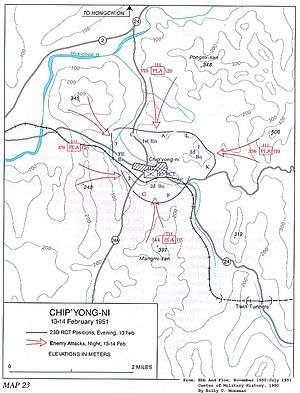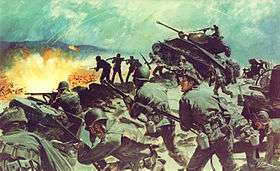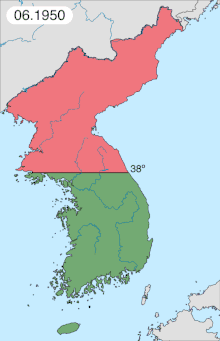Battle of Chipyong-ni
The Battle of Chipyong-ni (French: Bataille de Chipyong-ni), also known as the Battle of Dipingli (Chinese: 砥平里战斗; pinyin: Dǐ Pīng Lĭ Zhàn Dòu), was a decisive battle of the Korean War, that took place from 13–15 February 1951 between US and French units of the US 23rd Infantry Regiment and various units of the Chinese People's Volunteer Army (PVA) around the village of Chipyong-ni. The result was a United Nations Command victory. The battle, along with the Third Battle of Wonju, has been called "the Gettysburg of the Korean War," and represents the "high-water mark" of the Chinese invasion of South Korea. Due to the ferocity of the Chinese attack and the heroism of the defenders, the battle has also been called "one of the greatest regimental defense actions in military history."
| Battle of Chipyong-ni | |||||||
|---|---|---|---|---|---|---|---|
| Part of the Korean War | |||||||
 Map of the Battle of Chipyong-ni on the night of 13–14 February 1951 | |||||||
| |||||||
| Belligerents | |||||||
|
| |||||||
| Commanders and leaders | |||||||
|
|
| ||||||
| Strength | |||||||
|
US sources: 25,000[2] Chinese sources: <6,000[3] | 4,500[4] | ||||||
| Casualties and losses | |||||||
|
US sources: 1,000 killed 2,000 wounded 79 captured[5]:4 Chinese sources: 1,800 killed and wounded[6] |
US sources: 51 killed 250 wounded 42 missing [5]:ii Chinese sources: 800 killed and wounded[7] | ||||||
Background
After Chinese forces entered Korea in November 1950, the UN forces, uncertain about the intentions and combat capabilities of the Chinese, drew back behind the 38th parallel and waited to see what the Chinese would do. Plans were even made for complete withdrawal from the peninsula.[8] In this climate of general uncertainty, Lt. General Matthew B. Ridgway decided to make a stand at Chipyong-ni and also at Wonju.[4] He recognized that the Chinese had overstretched their supply lines, and would not be able to keep up their advance much longer. He intended to use the 23rd RCT to blunt the Chinese attack so that the Eighth Army could carry out a counterattack before the Chinese had a chance to consolidate their forces.[1]
Prelude
Following the Battle of the Twin Tunnels on 1 February 1951, the 23rd Regimental Combat Team under the command of Paul L. Freeman, Jr. reached the important crossroads town of Chipyong-ni on 3 February and immediately set up a perimeter defense.[2] Over the next few days, they dug in and were reinforced by artillery, tank, and engineer elements. By February 13, their strength consisted of three infantry battalions; the French Infantry Battalion and First Ranger Company, both attached to the regiment; the 37th Field Artillery Battalion; Battery B, 82nd Antiaircraft Artillery Automatic Weapons Battalion; Battery B, 503rd Field Artillery Battalion; Company B, 2nd Engineer Battalion (Combat); elements of the 2nd Signal Co. (attached); and a platoon from the 2nd Medical Battalion. In all, Freeman had 4,500 men under his command, including 2,500 front-line infantrymen.[4]
On February 11, the Chinese attacked X Corps at Hoengsong as part of their Fourth Phase Offensive, driving back two divisions and leaving the 23rd Regiment at Chipyong-ni behind enemy lines and exposed to a Chinese attack.
The Chinese then sent the entirety of the 39th Army, and divisions of the 40th and 42nd armies to encircle and destroy Chipyong-ni.[5]:254
On the morning of the 13th, after a patrol revealed a significant Chinese presence on Route 24 to the north of the town, Lt. General Edward Almond, commander of X Corps ordered the 23rd Regiment to withdraw to the Yoju area, 15 miles (24 km) to the south, due to concerns that it would be encircled by Chinese forces. However, later on the same day, Ridgeway reversed this decision after meeting with his superior, Douglas MacArthur. He insisted on attempting to hold Chipyong-ni, and directed Almond to attack north in order to relieve the regiment if it was cut off.[9]
Informed of this, Freeman began to bulk up his defenses, and requested resupply by air and airstrikes for the 14th. He deployed his 1st Battalion to the northern part of the perimeter, the 2nd to the south, and the 3rd on the east, with the French on the western side. The 1st Battalion's Company B and the Rangers were kept in reserve behind the 1st Battalion line.[2]
Battle
Day 1
During the afternoon of the 13th, the Chinese forces took up positions around the 23rd's perimeter, but any attempts to advance were stopped by artillery. The U.S. forces observed heavy flare activity throughout the afternoon. Early in the evening, Freeman gathered his unit commanders and told them to expect an attack during the night.[4]
Between 22:00 and 23:00 hours, the Chinese directed small arms and mortar fire at the Americans from the northwest, north, and southeast. C Company, positioned near Route 24 on the northern perimeter, was hit hardest. Slightly after 23:00, Chinese infantrymen moved down hill 397, attacking E and G Companies. They were driven off, but shortly before 24:00 hours, an intense mortar and artillery barrage hit C Company.
After this, the defenders heard bugles, whistles, and bells, followed by a concerted infantry attack all along the perimeter. By midnight, only 3rd Battalion in the east was not engaged. The attack was fierce but brief, intended to probe the US defenses, ending in most places soon after midnight. It was followed by an assault on 1st Battalion at 01:00, but when this was repulsed the Chinese forces dug in beneath the 1st Battalion positions.
At 00:15, a bloody assault was made from the east against K Company. The attack was fought off, but the shooting remained fierce enough that no ambulance could get through to evacuate K Company's wounded. In the north, the French were attacked from hill 345. C Company was forced to withdraw slightly, but it counterattacked and its positions were regained.
G Company was attacked at 02:30 and 04:00. During the 04:00 attack, it was in danger of being overwhelmed, so a regimental tank was dispatched for support.
At 05:30, the attacks began to let up. There was still fighting in the west and east, however. At first light the Chinese renewed their attack in the west, against the 3rd Battalion. However, as daylight approached the Chinese knew they would be vulnerable to Air Force strikes; at 07:30 a Chinese bugler blew a call to withdraw.

Day 2
At dawn on the 14th, Freeman had sustained about 100 casualties and been hit in the leg by mortar fire himself. He retained command despite his injuries. Air support kept the Chinese away during the daylight hours of the 14th, but the Americans were running dangerously low on ammunition.
At dusk, artillery fire began to come down on the perimeter, followed soon after by infantry assaults. The 3rd Battalion was hit hard, and mortar fire rained down on the regimental command post for an hour. At midnight the main assault began, with a Chinese wave attack striking A Company, then veering over towards C Company and the French.
By 01:30, K Company in the east had been assaulted twice, and everywhere the ammunition shortage was critical. Air Force planes dropped ammunition down to the soldiers, but many of them were shot when they tried to get to it. Throughout the night, C-47 Skytrain transports dropped flares to provide illumination.
At 02:30, I Company's perimeter was penetrated, the first successful penetration of the battle. Units of I Company, however, supported by L Company and the machine-gunners of M Company, counterattacked and restored the perimeter.
Fighting was fiercest, however, in the south, where at around 03:15, Chinese forces broke through the perimeter and forced the defenders out of their positions, a serious threat to the beleaguered regiment. At daybreak on the 15th, Freeman ordered the Ranger company, a platoon from F Company, and 14 men from G Company to counterattack, but they were driven back at 06:15 after sustaining heavy casualties in hand-to-hand fighting. At noon on the 15th, B Company, in full view of the Chinese and across open ground, attacked once more but this time was pinned down by Chinese machine guns. By 12:30, it was still 9,000 yards from what remained of the earlier counterattack.
In desperation, the regiment sent out four tanks under Captain Perry Sager to attempt to flank the Chinese.
Right about this time, at 15:45, units of the 5th Cavalry Regiment (Task Force Crombez) moved out from a town to the south to support the men at Chipyong-ni.[10]
At 14:00, the Chinese retreated from their position inside the perimeter under the pressure of an Air Force napalm bombardment and an attack by B Company, in which they lost 50% of their men. When they gained the position at 16:30, they could see Task Force Crombez in the distance, which arrived at 17:25 with nearly 20 tanks. The Chinese withdrew.
The Chinese perspective
Although most western historians claimed that there were over 20,000 Chinese soldiers participating in this battle, the Chinese military record showed only eight Chinese infantry regiments (around 8,000 men) in this region with few heavy weapons, including the 343rd Regiment, 344th Regiment (both from the 115th Division, 39th Army), 356th Regiment, 357th Regiment (both from the 119th Division, 40th Army), 359th Regiment (from the 120 Division, 40th Army), 375th Regiment (from the 125th Division, 42nd Army), 376th Regiment and 377th Regiment (both from the 126 Division, 42nd Army).
According to the memoir of Xu Guofu, the commander of the 119th Division and also the field commander of the Chinese forces at Chipyong-ni, five Chinese infantry regiments were deployed to attack the UN troops in this area by Deng Hua, the third commander and commissar of the Chinese People Volunteer Army.[11] However, two regiments (343rd & 376th) lost their ways in dark and went to wrong places.[12] Due to poor communications, only three regiments (356th, 357th, and 359th) around 3,000 soldiers, were actually committed in the attack on Chipyong-ni.
After a bloody fight overnight, in the morning of 15 February, Xu's troops broke through the perimeter and expected to launch another attack when night came again. But Xu received an order from Wen Yucheng, commander of the 40th Army, to withdraw as the Chinese discovered that there were over 6,000 UN troops in Chipyong-ni instead of the initial estimate of 1,000 men. Xu also insisted that the West overestimated Chinese casualties. According to him, casualties of the three Chinese regiments committed in the attack were a little over 900 killed and wounded, of which one third were killed (Xu does not give figures for non-combat casualties or prisoners).[13]
Aftermath
.jpg)
Casualties on the UN side of the conflict were 51 killed, 250 wounded, and 42 missing. The Chinese lost approximately 1,000 killed and 2,000 wounded.[5]
The battle offered an incredible boost to the morale of Eighth Army, which had up until now seen the Chinese as an invincible juggernaut. Soon afterwards, Operation Killer was launched, followed by Operation Ripper. The Chinese, who had hopes of driving the UN forces to the sea, were themselves driven back. Eventually, this led to the start of peace negotiations in July 1951.
Matthew Ridgway, speaking to Congress in May 1952, said of the battle:
I shall speak briefly of the Twenty-third United States Infantry Regiment, Colonel Paul L. Freeman commanding, [and] with the French Battalion….Isolated far in advance of the general battle line, completely surrounded in near-zero weather, they repelled repeated assaults by day and night by vastly superior numbers of Chinese. They were finally relieved….I want to say that these American fighting men, with their French comrades-in-arms, measured up in every way to the battle conduct of the finest troops America and France have produced throughout their national existence.[2]
The Chinese leadership, in a critique of the battle, stated that
In the conduct of the....battle command, we have underestimated the enemy. In view of their past characteristics in battle, we expected the enemy to flee at Chipyong-ni, after the enemy at Hoengsong was annihilated.[5]:253
Awards
On February 20, Sergeant First Class William S. Sitman, a machine gun section leader in M Company,[14] was posthumously awarded the Medal of Honor for bravery during the battle when he threw himself on a grenade to save five of his comrades.[15]
After the battle, the 23rd RCT and all attached units were awarded the United States Army Distinguished Unit Citation.[5]:4
See also
- 23rd Infantry Regiment (United States)
- Battle of the Twin Tunnels
- French Battalion in the Korean War
Notes
- Appleman, Roy (1990). Ridgway duels for Korea. Texas A and M University Press. ISBN 0890964327.
- "Ansil L.Walker Recalls the Battle of Chipyong-ni During the Korean War". HistoryNet.com. Archived from the original on 15 November 2009. Retrieved 10 November 2009.
- http://history.people.com.cn/n/2014/0126/c372327-24234044.html
- Gugeler, Russel A. "Chapter 8: Chipyong-ni". Combat Operations in Korea. US Army.
- Thomas M. Ryan (1990). "Battle of Chipyong-ni Feb 1951 Staff Ride Packet" (PDF). koreanwar-educator.com. Retrieved 10 November 2009.
- http://history.people.com.cn/n/2014/0126/c372327-24234044.html
- http://history.people.com.cn/n/2014/0126/c372327-24234044.html
- "Battle of Chip'yong-ni February 1951" (PDF). 2nd Infantry Division. Archived from the original (PDF) on 22 November 2009. Retrieved 10 November 2009.
- Bill C. Mossman. "Ebb and Flow November 1950-July 1951: Chapter 15: Defending the Wonju Line". Archived from the original on 15 November 2009. Retrieved 10 November 2009.
- Gugeler, Russel A. "Chapter 9: Task Force Crombez". Combat Operations in Korea. US Army.
- "砥平里之战伤亡真相 徐国夫少将大声疾呼军史误人 - 新闻 - 加拿大华人网 - 加拿大华人门户网站". www.sinoca.com.
- 2751. "南京军区原副司令员:砥平里战斗的得与失【2】--文史--人民网". history.people.com.cn.CS1 maint: numeric names: authors list (link)
- "砥平里之战伤亡真相 徐国夫少将大声疾呼军史误人 - 新闻 - 加拿大华人网 - 加拿大华人门户网站". www.sinoca.com.
- Center of Military History. "The Korean War: Restoring the Balance". US Army. Archived from the original on 15 November 2009. Retrieved 25 November 2009.
- ""WILLIAM S. SITMAN" entry". Medal of Honor Recipients: Korean War. CMH, U.S. Army. February 20, 1950. Archived from the original on 26 November 2009. Retrieved 2009-11-26.
References
- Appleman, Roy (1990). Ridgway duels for Korea. College Station, Texas: Texas A & M University Press. ISBN 0-89096-432-7.
- Hamburger, Kenneth Earl (2003). Leadership in the Crucible: The Korean War Battles of Twin Tunnels and Chipyong-ni. College Station, Texas: Texas A&M University Press. ISBN 978-1-58544-232-4.
- Summers, Harry G. Jr. (1999). Korean War Almanac. Replica Books. pp. 85–86. ISBN 978-0-7351-0209-5.
External links
| Wikimedia Commons has media related to Battle of Chipyong-ni. |
- Letter from Chip-yong-ni - 13 February 1951 - Return to Heartbreak Ridge
- Letter from Chip-yong-ni - 14-15 February 1951 - Return to Heartbreak Ridge
- Remembering the Battle at Chipyong-ni - 2nd Infantry Division Story
- Defending the Wonju Line, 13-18 February 1951
- Leadership in Battle: The Siege at Chipyong-ni - Army
- Battle of Chipyon-Ni Feb 1951 Staff Ride Packet - Korean War Educator
- The Controversial Task Force Crombez - Army
- Heroes of the Korean War - Colonel Paul Freeman - ROKDrop
- Korean War History - Wonju and Chipyong-ni
- A Surgeon's Story: Treatment of the United Nations Wounded at Chipyong-ni
News
- Trapped U.N. Force Rescued After Four Days - The Bend Bulletin, Feb. 15, 1951
- Strong Enemy Forces Attempt Flanking Drive - St. Petersburg Times, Feb. 16, 1951
- War: Stand at Chipyong - TIME, Feb. 26, 1951
- Reds Near Wonju and Chipyong In Two-Pronged Drive - The Canberra Times, Feb. 15, 1951
- Diggers in Grim Korean Battle - The Age, Feb. 17, 1951
- Encircling Reds Smashed by Relief Force - The Canberra Times, Feb. 16 1951
- THE ALLIES: Distinguished Unit - TIME, Mar. 12, 1951
